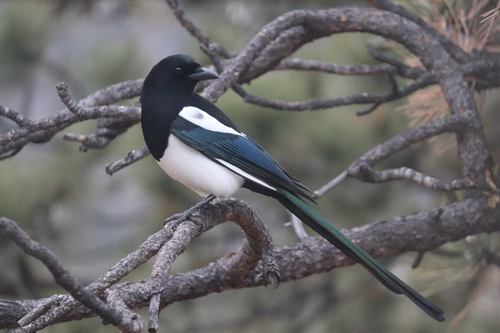
Black-billed Magpie
The Black-billed Magpie (Pica hudsonia) is a striking and intelligent bird native to western North America. Known for its bold black and white plumage, long tail, and raucous calls, it's a familiar sight in open woodlands, grasslands, and even urban areas. This species plays a crucial role in its ecosystem as both a predator and scavenger, helping to control insect populations and clean up carrion. It is also recognized for its complex social behaviors and remarkable cognitive abilities, often compared to those of parrots and even primates. While not holding specific cultural significance comparable to ravens or crows in some indigenous cultures, the magpie's adaptability and presence have made it a notable part of the western landscape.
45-60 cm
Length
56-61 cm
Wingspan
Least Concern
Conservation Status
Distribution
Western North America, from southern Alaska through British Columbia and Alberta, south to the southwestern United States (eastern California, Nevada, Utah, Colorado, Arizona, New Mexico, and parts of neighboring states). They are generally non-migratory, though some populations may move to lower elevations in winter.
Lifespan
Typically 4-6 years in the wild, but can live up to 15 years in captivity.
Black-billed Magpie's Habitat
Habitat Types
Open woodlands, Grasslands, Savannas, Agricultural fields, Riparian areas, Urban and suburban environments
Climate Zones
Temperate, Subarctic, Semi-arid
Adaptations
Black-billed Magpies are highly adaptable to a range of conditions. Their strong bills allow them to exploit a wide variety of food sources. They are also tolerant of human presence, often thriving in areas with moderate human disturbance.
Variations
While *Pica hudsonia* is generally considered monotypic (no recognized subspecies), some subtle regional variations in size and plumage may exist, but these are not formally recognized as distinct subspecies.
Appearance
Breeding Plumage
Plumage is generally consistent year-round, with no significant differences between breeding and non-breeding seasons.
Seasonal Feather Changes
Minor wear and tear may cause slight variations, with fresher plumage after molting.
Sex Based Plumage Differences
Sexes are visually similar, although males may have slightly glossier plumage.
Notable Features
Long, graduated tail, often making up half the bird's total length., Black and white plumage with iridescent blue-green on the wings and tail., Strong, slightly curved black bill.
Diet and Feeding
Primary Foods
Insects, Spiders, Carrion, Small mammals, Bird eggs and nestlings, Seeds, Grains, Fruits, Berries
Foraging Behavior
Black-billed Magpies are opportunistic omnivores, foraging on the ground, in trees, and around human settlements. They often cache food in scattered locations for later retrieval.
Specializations
Their strong bill allows them to probe the ground for insects, flip over objects, and tear into carrion. They are also known to steal food from other birds and mammals.
Seasonal Diet Variations
Diet shifts seasonally based on food availability. Insects are more prevalent in the diet during warmer months, while seeds, grains, and carrion become more important in winter.
Behavior
Social Structure
Black-billed Magpies are highly social birds, often found in pairs or family groups. They can also form larger flocks, especially outside the breeding season.
Communication
A variety of harsh, chattering calls., Rattling calls., Whistle-like calls., Visual displays, such as tail-flicking and wing-spreading.
Migration
Generally non-migratory, although some populations may move short distances to lower elevations or more favorable areas in winter.
Territorial or Group Behaviors
During the breeding season, pairs are territorial, defending their nesting area from other magpies. Outside the breeding season, they may form loose flocks and forage together.
Conservation
Threats
Habitat loss and fragmentation, Pesticide use (indirectly through prey), Human persecution (historically, due to perceived threats to livestock and crops), Collisions with vehicles
Protection Programs
Protected under the Migratory Bird Treaty Act in the United States and Canada., Habitat conservation efforts in some areas.
Local National Laws
Protected under various state and provincial wildlife regulations.
Population Trend
Stable
Population Estimates
The global population is estimated to be around 9 million individuals.
Interesting Facts
Magpies are one of the few bird species known to recognize themselves in a mirror.
This indicates a high level of self-awareness, a trait usually associated with primates.
They are known to hold 'funerals' for deceased magpies.
When a magpie dies, others may gather around the body and vocalize, although the exact purpose of this behavior is still debated.
Black-billed Magpies are skilled mimics.
They can imitate the calls of other birds and even human speech, though this is less common than in some other corvids.
Magpies will work cooperatively.
During the breeding season, helper birds (usually offspring from previous years) may assist in raising young.
Faqs about Black-billed Magpie
Are Black-billed Magpies related to crows?
Yes, Black-billed Magpies are members of the Corvidae family, which also includes crows, ravens, jays, and nutcrackers.
Do Black-billed Magpies mate for life?
Black-billed Magpies are generally monogamous and may form long-term pair bonds, but 'divorce' can occur.
Are Black-billed Magpies aggressive?
Magpies can be aggressive, especially during the breeding season when defending their nests. They may also mob predators or perceived threats.
What should I do if I find a baby magpie?
If the bird appears healthy and is feathered, it's best to leave it alone. The parents are likely nearby. If it's injured or truly orphaned, contact a local wildlife rehabilitator. *Consult a professional for expert advice.*
Copyright @ Nature Style Limited. All Rights Reserved.
 English
English